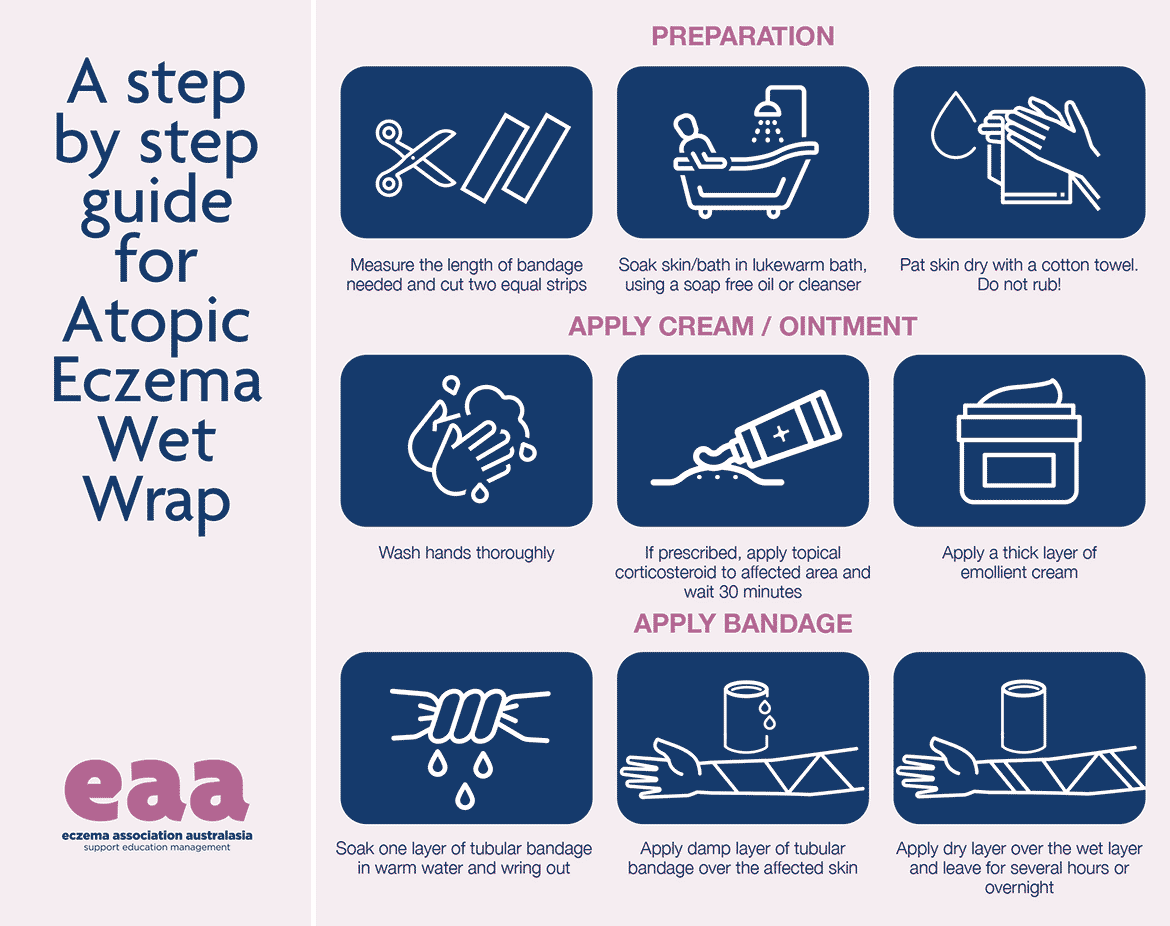What is wet wrapping?
Wet wrapping is a bandaging system used to control the symptoms of eczema that can help to reduce the amount of itching and aids sleep. Wet wraps should be used on red, dry and itchy skin but should never be used on infected skin. Wet wrap therapy needs to be supervised by their therapy or health professional.
What you need:
- Hypoallergenic bath oil or soap substitute
- Elasticated Tubular bandages (premeasured and cut)
- Large amounts of a moisturiser. You will need approximately 500gms for one week.
- Topical steroids (if prescribed by your doctor)
- A bowl of warm water
How to make up the suit:
Measure and cut the lengths of tubular bandage you need:
- Arms – measure from the top of the shoulders to tips of fingers and add three inches. Cut four pieces (two for each arm) or if hands are to be covered, cut two double lengths.
- Legs – measure from the top of the thigh to tips of the toes and add three inches. Cut four pieces two for each leg) or two pieces if covering the toes.
- Body – measure from top of the neck to the base of the bottom. Cut two lengths. Cut an armhole at each side.
- Ties – Cut eight one-inch strips from left over bandages.
How to apply wet wrap:
- Have a bath using your bath oil or soap substitute.
- Pat the skin dry and then put on topical steroids and creams, or creams only. Put on in large amounts, ‘larded’ on.
- Apply cream using downward strokes that follow the direction that hairs grow in.
- Put one layer of each bandage in a bowl of warm water (if double lengths are used for limbs, then only soak one half).
- Squeeze the water out of the body part bandage and put this on first, covering it with the dry layer.
- Repeat this with each arm and leg. If you are using a double layer, fold the dry portion back over the wet layer after twisting the ends. (Ensure that the fingers and toes have room to move.)
- Make two holes at the tops of each arm and leg bandage and tie them onto the vest with ties, one at the front and one at the back, like suspenders. Normal clothes or nightclothes can be worn over the bandages.


Duration and frequency that patients with eczema use wet wraps:
Patients should apply in short, concentrated periods until the eczema is under control and the skin is in a good condition. They can be used on eczema that is moderate or severe and that is not infected.
Wet wraps can be put on twice a day, morning and evening, or used at night only and can be used on most areas of the body except the scalp. The face can be wet wrapped.
How can I get hold of the bandages?
You can obtain them from your Pharmacy in 1, 3 and 5 metre lengths (or you can buy them online). They can be washed and re-used several times. They may shrink a little so always cut them with a little extra length.
Cost effective alternative to tubular bandaging:
Firm fitting and correctly sized cotton or bamboo garments such as leggings, long or short sleeved tops, underwear, socks or even gloves can be used. These are less expensive, readily available at department stores, are more comfortable for the sufferer and can target specific areas of the body or the body as a whole in either children or adults. Garments can be pre-dampened ready for wear by putting them through a warm rinse cycle then a spin cycle in any washing machine.
Advantages of wet wraps
- Clean and adaptable way to control eczema.
- You can learn how to use them at home.
- Emollients and topical steroids stay on the areas of eczema.
- The water in the bandages evaporates and helps to ease itching.
- Two-layer bandage protects the skin against scratching.
- Weaker steroids can be used.
- People who use wet wraps will often find that they or their children sleep better.
- Using wet wraps can also mean that you or your child may not have to go into hospital for treatment.
- You will enjoy feeling in control of your own or your child’s eczema.
Disadvantages of wet wraps
- Older children and adults may find they feel quite cold when wearing wet wraps because they have a larger body surface.
- The skin sometimes reacts to elastane in the bandages. This is very rare.
- Wet wraps can take a long time to put on, especially when you are new to them. Some children may also need to use them for long periods of time.
- Treatment may need changing when your eczema is infected.
- Wet wraps can dry out quickly, especially during the summer, and will need to be kept damp by applying water or emollients regularly.
Information contained in this article was obtained from the NEA.
It is not the policy of the Eczema Association of Australasia Inc to recommend or endorse any product or treatment. It is part of the role of the Association to provide information on a wide range of products and treatments to keep those involved with eczema as fully informed as possible as to all options available. For medical advice, consult your health professional.




